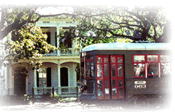|
 These mansions stand in the
center of large grounds and rise, garlanded with
roses, out of the midst of swelling masses of
shining green foliage and many-colored blossoms.
No houses could well be in better harmony with
their surroundings, or more pleasing to the
eye. -- Mark Twain, speaking of the
Garden District. These mansions stand in the
center of large grounds and rise, garlanded with
roses, out of the midst of swelling masses of
shining green foliage and many-colored blossoms.
No houses could well be in better harmony with
their surroundings, or more pleasing to the
eye. -- Mark Twain, speaking of the
Garden District.
 For many visitors and
residents of New Orleans, no locale embodies the
grandeur and glory of the Southern aristocracy
of history and legend better than the Garden
District. Where the French Quarter is vibrant
and multi-textured, the Garden District is
gracious and stately -- an elegantly adorned
window to a bygone era. For many visitors and
residents of New Orleans, no locale embodies the
grandeur and glory of the Southern aristocracy
of history and legend better than the Garden
District. Where the French Quarter is vibrant
and multi-textured, the Garden District is
gracious and stately -- an elegantly adorned
window to a bygone era.
Developed mainly between 1840 and 1900, the
Garden District runs from Magazine Street to St.
Charles Avenue and from Jackson Avenue to
Louisiana Avenue. It comprises one of the
best-preserved collections of historic mansions
in the South -- if not the entire country. From
the expansive, 8,000-square-foot Short Villa at
1448 Fourth Street to the simple yet elegant
George Washington Cable home at 1313 Eighth
Street, the Garden District is a brilliant
tapestry of architectural styles and period
designs.
The area had its origins in a flood that
occurred upriver from the area in 1816. That
year, a crevasse, or break, in the Mississippi
River levee at the McCarty Plantation inundated
most of the plantations between the break and
the city of New Orleans. The flood resulted in a
thick layer of nutrient-rich alluvial silt being
deposited on the land, including the Livaudais
plantation; this new layer of soil encouraged
the luxuriant foliage growth that would later
give the Garden District its name.
Less than a decade after the flood, the
Livaudais marriage was as broken as the levee,
and Madame Livaudais retired to Paris. She sold
the plantation, which she had received as part
of her settlement, to a group of entrepreneurs
who promptly laid it out in large (for New
Orleans) lots.
The spacious home sites and rich,
garden-ready soil immediately began attracting
wealthy New Orleanians - particularly the many
well-heeled Americans that had flooded the city
after the Louisiana Purchase in 1803. Disdained
by the old French Creole gentry in the French
Quarter, these new arrivals thumbed their noses
at the Creoles by constructing sumptuous
mansions and the Garden District was born.
|


 These mansions stand in the
center of large grounds and rise, garlanded with
roses, out of the midst of swelling masses of
shining green foliage and many-colored blossoms.
No houses could well be in better harmony with
their surroundings, or more pleasing to the
eye. -- Mark Twain, speaking of the
Garden District.
These mansions stand in the
center of large grounds and rise, garlanded with
roses, out of the midst of swelling masses of
shining green foliage and many-colored blossoms.
No houses could well be in better harmony with
their surroundings, or more pleasing to the
eye. -- Mark Twain, speaking of the
Garden District. For many visitors and
residents of New Orleans, no locale embodies the
grandeur and glory of the Southern aristocracy
of history and legend better than the Garden
District. Where the French Quarter is vibrant
and multi-textured, the Garden District is
gracious and stately -- an elegantly adorned
window to a bygone era.
For many visitors and
residents of New Orleans, no locale embodies the
grandeur and glory of the Southern aristocracy
of history and legend better than the Garden
District. Where the French Quarter is vibrant
and multi-textured, the Garden District is
gracious and stately -- an elegantly adorned
window to a bygone era.
